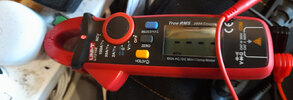8.3 amp is enough, with a stage charge the first stage at high amps is quite short, the problem with the lead acid battery is it will only absorb the charge slowly, the time taken is variable and depends in the main how long it has been discharged rather than by how much, the sulphur hardens on the plates, so left discharged for 6 months it could take a couple of weeks to charge, but it also means a battery discharged for a day takes longer to recharge than one left discharged for an hour.
If the battery is not fully recharged then you have some sulphur left on the plates to harden, so going back to the 50's with dynamos, we would put on an equalising charge over night once a month. But back then we had flooded batteries so we could top them back up, the early sealed batteries were in fact still flooded, they just had a vent system designed to recycle the water, latter we went to absorbed glass mat, (AGM) but both need a battery charger that will not over charge them, looking after fork lift batteries it was not unknown to use a gallon of water to top them up, same charger with AGM would kill them.
So if we take the 5 amp charger as an example, as the chart shows there are in real terms 4 stages 5 amp, 3 amp, 0.8 amp and 0.1 amp, the switch between stages is triggered by voltage, so we have looking at basics 12.8 as lower limit and 14.4 as upper limit, and if the lower limit is reached the charger steps up a stage, and if upper limit reached it steps down a stage, and when it steps down to 0.1 amp it is considered charged, it will continue to take charge after that point, but very little.
So with a non stage charger just a fixed voltage we can use the current instead, how much depends on battery size and condition, so if it were me I would fully charge with the stage charger first so I can measure the amps when fully charged, I would think likely 0.1 to 0.2 amp, this would present a problem, to measure 10 amp, and be able to see when down to 0.1 is too much of a range. So it would need a by-pass so it only measures up to 1 amp but is not damaged sending 10 amp through it. Likely a large diode would do this, the 0.6 threshold voltage would be enough to work the meter.
The cheapest tool station multi-meter will measure 10 amp, cost £20 and is digital so can also measure 0.1 amp on same scale, it does not say much about the meter, but I note separate terminal for amps, so likely a shunt built into the meter, so seems likely it will let current flow even if meter switched off, and mA range uses the other terminal, so seems likely switching through the mA ranges will cause no problem.
Personally I would use my meter,

and leave a loop of wire on dash to clamp it onto when I want to measure, I get so much more by paying the extra £15, but tool station version is £123, this is the cost of having upset ebay.


